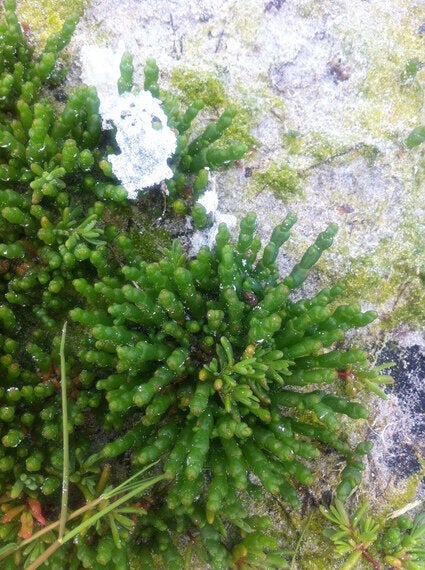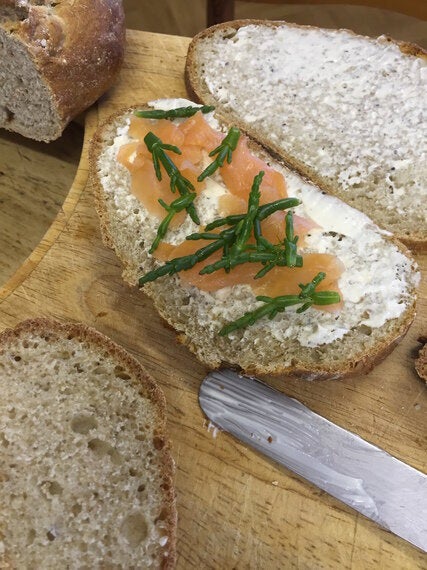
Glasswort or Marsh Samphire Salicornia europaea grows on salt marshes, often around estuaries.
To my mind it resembles a plant from Jurassic Park; mini cacti but without the prickly spikes. It is packed with alkali, which is why it was used in the manufacture of old English glassware. This is where the name glasswort originated. An old indigenous British plant, it can form green carpets when allowed and is steeped in British history. Glasswort has been harvested as an edible by generations of coastal dwellers. Glassmakers built their huts in amongst the marsh samphire for convenient harvesting. The herbalist Nicholas Culpeper praised the cleansing qualities of the juice of glasswort. In an industrial move from soap, some species (there are lots and they are difficult to identify) of marsh samphire are now cultivated off shore from Saudi Arabia, Eritrea and Mexico for the production of oil. In the winter months these cultivated plants make their way into British shops, as does glasswort from Israel. It's a delicious wild ingredient that British supermarkets are happy to supply, to those keen to eat glasswort out of season.
In Britain between June and September glasswort is abundant on many parts of the coastline, (Norfolk in particular). Glasswort grazing lamb commands a high price at the butcher's shop. Fishmongers repaid customer loyalty with a sprig or two of glasswort in parcels of fish. Some say that the best plants are washed by the tides but I'm not sure that I could taste the difference. Pick high up the stem because the base becomes woody with age. The roots belong to the landowner and must remain. Forage as early in the season as possible. The glasswort season begins on midsummer's day but it is often into July before I spy spigs worth foraging in Scotland.

When picking glasswort decent footwear is essential and you need a pair of scissors and a basket or bag. Kneeling is my preferred option but test the sand/mud for terra firma, otherwise it is a backbreaking business. This is the most delicious wild plant and when young, there is nothing nicer than carefully picking the tips (no roots) from the muddy sand, washing it in clean seawater and popping it into an egg or salmon sandwich. It is crunchy and bursts with seaside juices. Marsh samphire marries well with poached eggs, fish (with a hollandaise, if you aren't on a diet) and lamb.
What to do with it the kitchen:
Wash and rinse it several times under running water before use.
Refrigerate pickings in an unwashed state and wash, as required.
Traditionally both marsh and rock samphire were pickled for preservation. A clue to habitat is in the name. Marsh samphire is found on marshy mud flats and rock samphire on the cliffs.The author Patience Gray suggests that they are interchangeable in recipes. The author Jason Hill however, concurs with Hartley et al. and writes of marsh samphire: 'it makes a wholesome, though rather insipid vegetable dish, but it lacks the characteristic flavour of the true samphire' He adds; 'It cannot be used as a pickle.' I do pickle marsh samphire but my preference for both, is fresh is best. Identification of glasswort is relatively easy but if you are anxious, check out a decent fishmonger's counter before you head off to the beach.